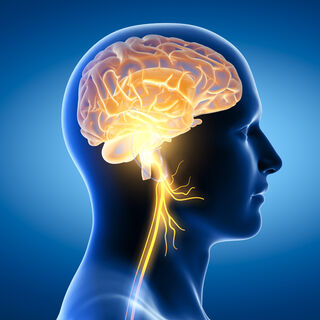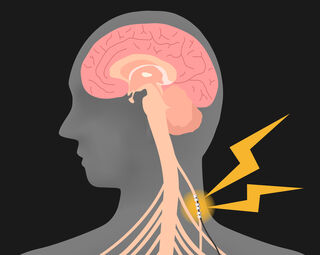Vagus Nerve
How Does Vagus Nerve Stimulation Reduce PTSD Symptoms?
Vagal nerve stimulation calms fight-or-flight responses and lowers inflammation.
Posted January 22, 2022 Reviewed by Devon Frye
Key points
- Vagus nerve stimulation (VNS) increases parasympathetic nervous system activity, counterbalancing fight-or-flight stress responses.
- Accumulating evidence suggests that non-invasive VNS bioelectronic devices may reduce post-traumatic stress disorder (PTSD) symptoms.
- Research suggests that VNS reduces PTSD symptoms by increasing parasympathetic activity and lowering inflammation as indexed by IL-6.

Stimulating the vagus nerve activates the parasympathetic branch of the autonomic nervous system in ways that curb fight-or-flight stress responses, which has a calming effect on the body and mind.
By counteracting hyperarousal and the sympathetic nervous system's stress response, vagus nerve stimulation may also reduce post-traumatic stress disorder (PTSD) symptoms by curtailing inflammatory responses.
A recent pilot study (Bremner et al., 2021) of a non-invasive transcutaneous cervical vagal nerve stimulation device found that three months of tcVNS treatment "resulted in a 31% greater reduction in PTSD symptoms compared to sham treatment."
"These preliminary results suggest that tcVNS reduces inflammatory responses to stress, which may in part underlie beneficial effects on PTSD symptoms," the authors explain. Omer Inan of the Georgia Institute of Technology's School of Electrical and Computer Engineering and the Coulter Department of Biomedical Engineering was this study's senior author.
This randomized, double-blind study was published in December of 2021 in the peer-reviewed Journal of Affective Disorders Reports. This research corroborates other sham-controlled research (Bremner et al., 2020) by the same team, which found that stimulating the vagus nerve using a handheld tcVNS device curbs inflammatory responses to stress as indexed by pro-inflammatory interleukin-6 (IL-6) cytokine biomarkers.
Another preliminary study (Lamb et al., 2017) of a non-invasive VNS device that targets the auricular branch of the vagus nerve via the outer ear found that this device increased parasympathetic activity and decreased sympathetic nervous system activity, which had positive effects on hyperarousal and the autonomic state of patients with PTSD. (See, "Vagus Nerve Stimulation via the Outer Ear Takes Center Stage.")
"These effects suggest that tVNS may modulate emotional state as reflected by downregulating fight-or-flight and upregulating a physiological state conducive to positive social engagement," first author Damon Lamb of the University of Florida and co-authors write.
All of the abovementioned research into non-invasive vagus nerve stimulation as a possible treatment for PTSD is in its early phases. These preliminary pilot studies were small; more research involving a larger sample size is needed.
However, there is a sense of urgency to help combat veterans and others with PTSD who haven't benefited from traditional therapies by giving them doctor-supervised access to new "breakthrough" treatments. Therefore, the U.S. Food and Drug Administration (FDA) has fast-tracked some of these devices via their "Breakthrough Devices Program."
What Is the FDA's Breakthrough Devices Program?
As part of the FDA's mission to "protect and promote public health," they offer manufacturers an expedited pathway to provide patients and health care providers faster access to recently invented medical devices by speeding up how these breakthrough devices are developed, assessed, and reviewed.
The Breakthrough Devices Program facilitates direct communication between the manufacturers of pioneering bioelectronic devices and people at the FDA during the premarket review phase. By getting the FDA's feedback about a novel medical device early on, manufacturers can address potential problems in a timely way while preserving the statutory standards for premarket approval, De Novo classification requests, and 510(k) clearances.

Two Non-Invasive VNS Devices Were Recently Given "Breakthrough Device Designation" by the FDA for PTSD Treatment
In July 2021, a non-invasive earbud device called the Phoenix—which delivers a mild electrical tingle that stimulates the vagus nerve via a patient's outer ear—received Breakthrough Device Designation from the FDA to treat post-traumatic stress disorder. This transcutaneous auricular vagal nerve stimulation (taVNS) device addresses underlying autonomic nervous system imbalances associated with PTSD by increasing parasympathetic activity.
In January 2022, a transcutaneous cervical vagal nerve stimulation (tcVNS) device called gammaCORE also received FDA Breakthrough Device Designation to treat PTSD. This handheld nVNS device stimulates the vagus nerve with pulses of electricity delivered through the skin on the side of a patient's neck.
"Current treatments for post-traumatic stress disorder involving medication and psychotherapy have limitations due to limited efficacy, possible side effects, and the unwillingness of many PTSD patients to engage in therapies that involve reliving traumatic memories," J. Douglas Bremner of the Emory University School of Medicine said in a news release about gammaCORE being part of the FDA's Breakthrough Devices Program.
"GammaCORE [non-invasive tcVNS] represents a new class of treatment separate from medication or psychotherapy that is safe, relatively free of side effects, and does not involve costly and invasive procedures for implantation, like previous VNS devices approved by the FDA for treatment of refractory depression," he added.
These novel technologies are promising and offer hope, but the FDA hasn't yet approved these nVNS devices for PTSD treatment. As mentioned, more research is needed.
Notably, a recent critical review (Yap et al., 2020) of tVNS published by Frontiers in Neuroscience concludes: "More rigorous systematic studies are required to investigate the effects of stimulation parameters, sites of stimulation, and electrode types on brain activation and clinical outcomes."
Until non-invasive vagus nerve stimulation gets its official seal of approval from the FDA for treating post-traumatic stress disorder, it's probably wise to proceed with caution and not overhype the potential of these devices.
Conflict of Interest Statement: This article is not an endorsement of the Phoenix or gammaCORE non-invasive vagus nerve stimulation (nVNS) devices, nor is this reportage on their Breakthrough Device Designation for the treatment of PTSD by the U.S. Food and Drug Administration intended as medical advice or a recommendation. This post's author is not paid by or associated with electroCore Inc. or Evren Technologies, Inc.; there is no conflict of interest.
As always, ask your doctor about the possible benefits and potential risks of using any bioelectronic medical device and follow the prescribed usage instructions closely.
References
J. Douglas Bremner, Matthew T. Wittbrodt, Nil Z. Gurel, Mobashir H. Shandhi, Asim H. Gazi, Yunshen Jiao, Oleksiy M. Levantsevych, Minxuan Huang, Joy Beckwith, Isaias Herring, Nancy Murrah, Emily G. Driggers, Yi-An Ko, MhmtJamil L. Alkhalaf, Majd Soudan, Lucy Shallenberger, Allison N. Hankus, Jonathon A. Nye, Jeanie Park, Anna Woodbury, Puja K. Mehta, Mark H Rapaport, Viola Vaccarino, Amit J. Shah, Bradley D. Pearce, Omer T. Inan. "Transcutaneous Cervical Vagal Nerve Stimulation in Patients with Posttraumatic Stress Disorder (PTSD): A Pilot Study of Effects on PTSD Symptoms and Interleukin-6 Response to Stress." Journal of Affective Disorders Reports (First available online: July 10, 2021) DOI: 10.1016/j.jadr.2021.100190
J. Douglas Bremner, Nil Z. Gurel, Yunshen Jiao, Matthew T. Wittbrodt, Oleksiy M. Levantsevych, Minxuan Huang, Hewon Jung, MdMobashir H.Shandhi, Joy Beckwith, Isaias Herring, Mark H. Rapaport, Nancy Murrah, Emily Driggers, Yi-An Ko, MhmtJamil L. Alkhalaf, Majd Soudan, Jiawei Song, Benson S. Ku, Lucy Shallenberger, Allison N. Hankus, Jonathon A. Nye, Jeanie Park, Viola Vaccarino, Amit J. Shah, Omer T. Inan, Bradley D. Pearce. "Transcutaneous Vagal Nerve Stimulation Blocks Stress-Induced Activation of Interleukin-6 and Interferon-γ in Posttraumatic Stress Disorder: A Double-Blind, Randomized, Sham-Controlled Trial." Brain, Behavior, & Immunity - Health (First available online: September 11, 2020) DOI: 10.1016/j.bbih.2020.100138
Damon G. Lamb, Eric C. Porges, Greg F. Lewis, and John B. Williamson. "Non-invasive Vagal Nerve Stimulation Effects on Hyperarousal and Autonomic State in Patients with Posttraumatic Stress Disorder and History of Mild Traumatic Brain Injury: Preliminary Evidence." Frontiers in Medicine (First published: July 31, 2017) DOI: 10.3389/fmed.2017.00124
Jonathan Y. Y. Yap, Charlotte Keatch, Elisabeth Lambert, Will Woods, Paul R. Stoddart, and Tatiana Kameneva."Critical Review of Transcutaneous Vagus Nerve Stimulation: Challenges for Translation to Clinical Practice." Frontiers in Neuroscience (First published April 28, 2020) DOI: 10.3389/fnins.2020.00284




